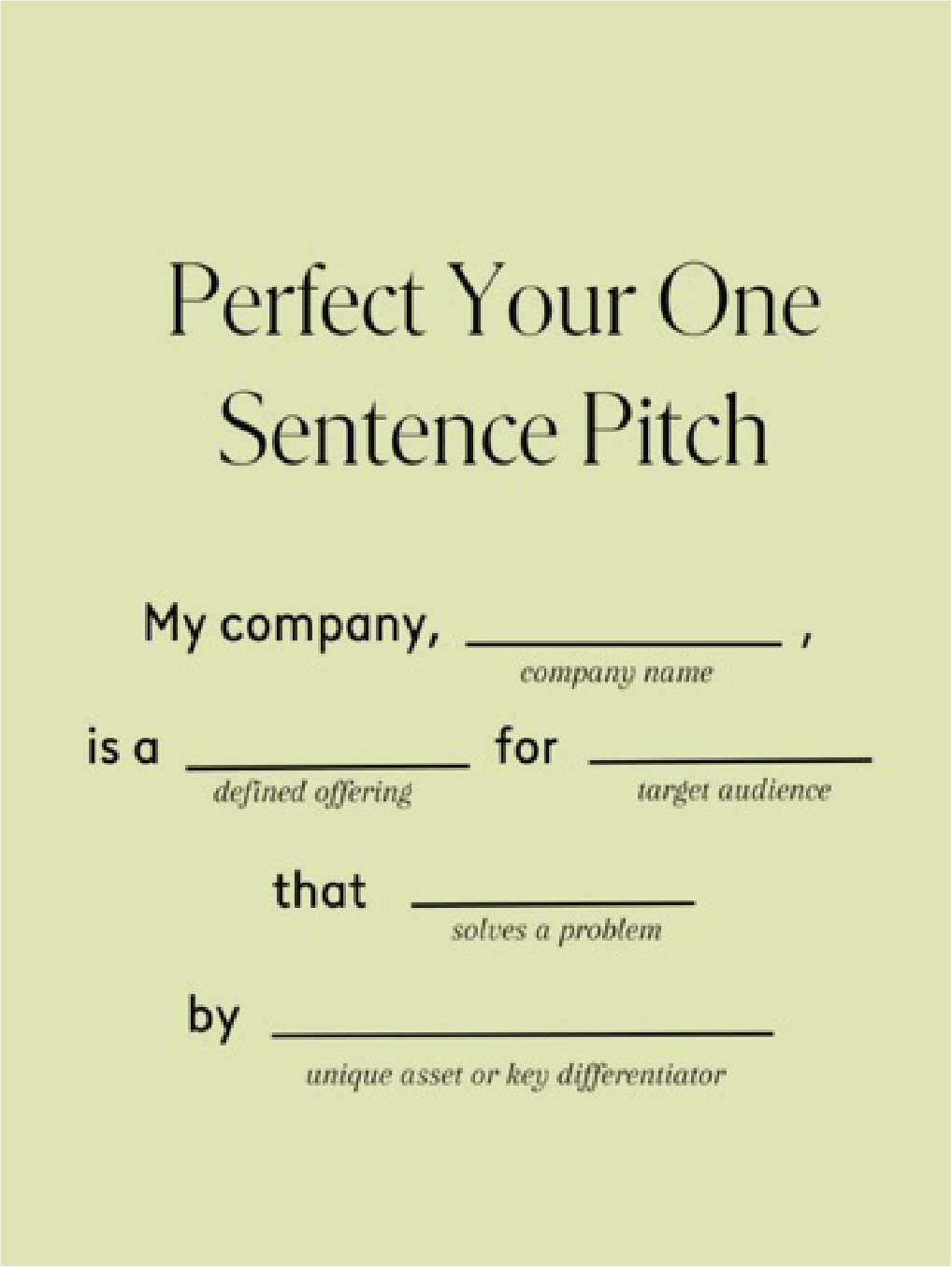How to Create a One-Sentence Brand Pitch
In a recently viewed Instagram post, I noticed a simple approach to creating a one-sentence pitch. It read..

So, I tried it out for Food Biz Mentoring….
“Food Biz Mentoring empowers food and beverage entrepreneurs to realize their culinary retail dreams from concept to commercialization with access to our Think Tank of food industry experts.”
OR
“Food Biz Mentoring empowers food and beverage entrepreneurs to overcome the pain points in the commercialization process so they can realize their culinary retail dreams with access to our Think Tank of food industry experts.”
OR
“Food Biz Mentoring is a Think Tank of food experts that can provide comprehensive support and guidance to food and beverage entrepreneurs at every stage of a food product’s journey to market, from concept development to successful food placement at retail, while leveraging their deep expertise in the food industry.”
Creating the perfect brand pitch can be challenging for several reasons:
Complexity of Brand Identity: Brands are multifaceted and complex entities. They encompass values, mission, vision, target audience, products or services, and more. Distilling all these elements into a concise and compelling pitch can be difficult. Also, remember that your target audience can drive this exercise and make it even more challenging.
Clarity: A brand pitch must be clear and easily understood. Balancing brevity with clarity is not easy, especially when dealing with intricate or innovative concepts. This point is also important when you select your keywords as they have to be visual for the listener.
Competition: In today’s market, competition is fierce. Brands are constantly vying for attention, so your pitch must stand out amidst a sea of competitors. We know it can be challenging when you review the competitive set as they have had the help of wordsmiths and timing so it feels as though you can’t find enough words to be different or unique.
Audience Variability: Different audiences may require different pitches. What works for one group may not work for another. Finding a pitch that resonates with various target demographics can be challenging. I often suggest you think about the brand Jello. Moms use it for kids, chefs for culinary dishes, and Weight Watchers for low-calorie desserts. These are all broad and sizable target groups worth pitching. How do you decide which one you will address first?
Evolution of Brand: Brands evolve over time. What might have worked initially may not align with the brand’s current positioning or values. Updating the pitch to reflect these changes while maintaining consistency can be tricky. You may also discover your target audience uses your brand differently from what you initially envisioned, so change may be required. Baking soda is a prime example.
Emotional Connection: A successful brand pitch often hinges on creating an emotional connection with the audience. This involves tapping into people’s feelings and aspirations, which can be a nuanced and challenging task. It is hard to believe that Jello needed an emotional connection – what do you think it was for moms with kids versus chefs?
Simplicity without Over-simplification: While a pitch needs to be simple and concise, it should not oversimplify the brand’s value proposition. Oversimplification can lead to a lack of differentiation and depth. Nike is our example of a swoosh, but we know it had to start with more before you got to the visual swoosh and “Just Do IT.”
Innovation and Creativity: Coming up with a pitch that is innovative and creative, yet authentic to the brand, requires a deep understanding of the market and a willingness to take risks. So often we are too close to our brand and our point of advantage may be lost in a list of features and benefits. This is where a Think Tank of experts can help.
Testing and Iteration: Crafting the perfect pitch often involves a process of trial and error. Brands may need to test different pitches and gather feedback before finding the one that resonates best. Friends and family are a help but a simple walk around a trade show or exhibiting at a farmers’ market may provide great insights.
Changing Trends: The landscape of marketing and consumer preferences is always evolving. What worked as the perfect pitch a few years ago may not be as effective today. Staying updated with trends and adapting the pitch is essential. Again, watch the trends and read Christine Couvelier’s trend report, this will keep you up on trends in food and beverage that can provide the necessary tweaks and edits to your pitch.
Internal Alignment: Achieving alignment within the organization regarding the brand’s pitch can be a hurdle. Different departments and stakeholders may have varying perspectives on what the brand represents. I know in this case using terms like entrepreneurial dreams seems a bit far, but Nike had to do the same exercise as we did.
External Factors: External factors like economic conditions, cultural shifts, and global events can impact how a brand’s pitch is perceived. Brands need to remain adaptable in response to such changes. COVID was a perfect example of a situation where brands had to adapt, talking trite issues when we were all under great stress brought out some wonderful new positions for brands. Dove did a great promotion around healthcare workers and their skin issues because of wearing masks all day. As a band Dove very quickly adapted and responded to market situations with meaningful messaging.
In conclusion, creating the perfect pitch for a brand is a complex task that involves understanding the brand deeply, connecting with the audience emotionally, and adapting to a constantly changing landscape. It requires a combination of creativity, strategy, and ongoing refinement. Need some help, check out www.foodbizmentoring.com for access to our Think Tank of experts.
